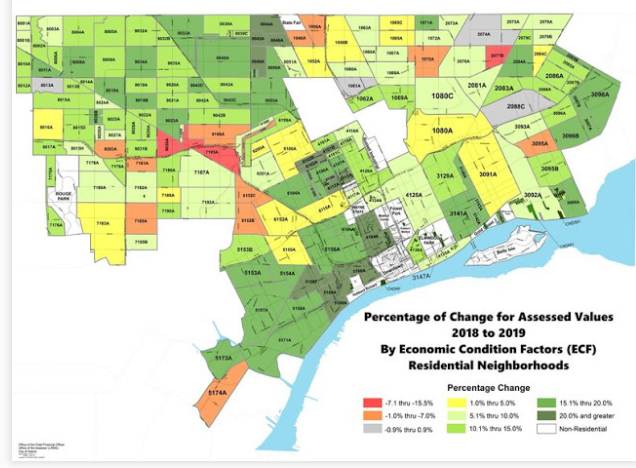Low house prices signify problems, not affordability
There’s a presumption that low housing prices are a sign of affordability, and a related belief that if housing prices rise, that its “a bad thing” because it must mean that a neighborhood is becoming less affordable.
If only it were that simple.
To economists, prices are signals of the value that people attach to things. In the case of housing, the price that someone is willing to pay for a house (or the rent one is willing to pay for an apartment) reflects collectively judgments about the value or utility of that residence. Some cities, and some neighborhoods and some houses command very low prices (or rents) because no one wants to live there. If a house is small, dingy, and poorly maintained, it will have a lower price than one that is roomy, clean, and in good shape. If a neighborhood is polluted, crime ridden and has poor schools, its housing will have lower prices than one that is clean and green, safe, and has high performing schools.
In effect, high or rising prices for real estate tend to reveal collective perceptions about the value and desirability of a house or neighborhood. This thinking is reflected in our analysis of what we call “the Dow of Cities.” We’ve noted that centrally located housing has appreciated relative to suburban housing over the past two decades in the United States. The greater appreciation of housing in close-in neighborhoods reflects in a tangible, monetary way, the growing relative value that Americans attach to being able to live in great urban environments.
Two recent articles explore what the ups and downs of real estate prices signal for housing. Both are drawn from rustbelt cities. First, our friend and City Observatory commentator Jason Segedy, dismantles the illusion that cheap houses are a sign of affordable neighborhoods. Everyone marvels at the affordability of housing in distressed Rustbelt cities. Why, you can pick up a house for at little as $40,000 in some neighobrhoods in Cleveland, Detroit, or Gary. But low housing prices are a mirage and a delusion, according to Segedy. He points out that the mortgage payment is just a fraction of the price of ownership, especially so for older homes. The reason they command such low purchase prices is because they typically have extensive deferred maintenance. He chronicles his own experience fixing up a relatively well-maintained older home in Akron. After replacing the roof, a rotting deck, a worn-out furnace, and attending to painting and other issues, he ended up spending as much on maintenance as on mortgage payments. In contrast, newer homes have higher mortgage payments, but–at least initially–much lower maintenance costs. And the kicker is that low home prices discourage maintenance, leading to the decay, and ultimately demolition of housing. It just doesn’t make sense to spend $10,000 on a new roof if it doesn’t increase the resale price of the house by at least that amount. Consequently, the bargain prices of housing in some older, distressed cities is not a cause of affordability celebrations, but a sign (and a contributor to) deep-seated malaise. As Segedy concludes, somewhat higher prices would actually be a good thing in many of these communities.
The second article comes from Pete Saunders, who relays a recent story from the Detroit News on rising home prices in the Motor City. According to a story in the Detroit Free Press, the median home sale in the city has risen 41 percent to 38,500. Prices of less than $40,000 are still too cheap, as Saunders notes, prices this low “aren’t indicators of an affordable real estate market, but a broken one.” But the good news here is that prices are headed up. That’s a sign of growing demand in Detroit, and also means that homeowners who maintain or fix up their homes may have a reasonable expectation of seeing a financial return for their expenditures. The map of home price appreciation shows that gains have been greatest in neighborhoods close to the central business district.
As we’ve noted before, there’s always a strong geographic component to neighborhood revitalization. Values seldom move upward at the same rate in every neighborhood, even in a broad-based turnaround. Some places will see larger gains, in large part because of the interdependency among different land uses. An area with new housing development is attractive for further housing development because its achieved (or is achieving critical mass). Similarly, such an area will be a favorable location for a new store, and in turn, the presence of a new store makes the neighborhood a more desirable place to live.
There’s a real bifurcation of US housing markets. In some places, housing is expensive, with average home prices well above the cost of replacement, chiefly due to regulatory constraints on new construction. But according to analyses by economists Ed Glaeser and Joseph Gyourko, vast swaths of the nation have housing prices that are below replacement cost, meaning that owners have little incentive to invest in maintenance. They estimate that about a third of all housing in the US is in markets where the median price of housing is less than 75 percent of replacement cost. That’s a good rough estimate of the share of the nation that finds itself in the Akron’s or Detroit’s situation, and which an increase in home prices would actually signal things are getting better.

